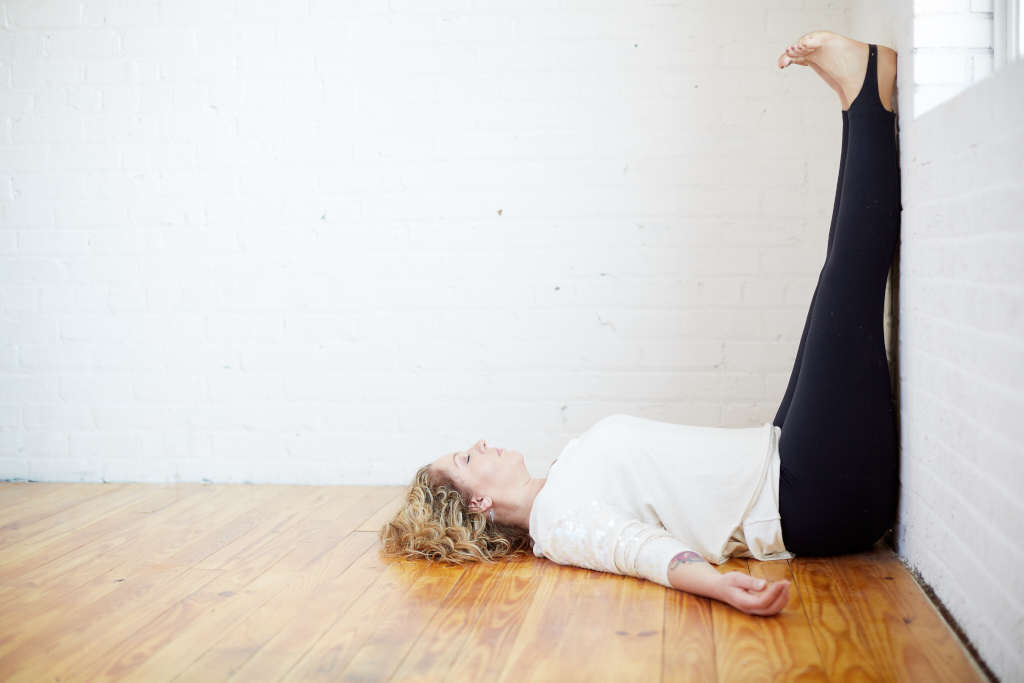
When it comes to women’s health, yoga has the potential to contribute to both prevention and healing.
Let’s talk about the health issues women are facing today. Once we have the background information on disease and risk factors, it will be clear why I’ve chosen these particular poses for my “Five to Thrive” list of top picks for women.
According to The Centers for Disease Control and Prevention, the top two leading causes for women’s deaths in 2010 were heart disease and cancer. When we look at the other leading health issues that affect women, we see a varied list including stroke, osteoporosis, depression, and autoimmune diseases.
While there are multiple factors at play in the manifestation of health issues and disease, some of which are beyond our control like genetics, there are other risk factors that we can influence with a healthy lifestyle.
According to The Mayo Clinic, adoption of a healthy lifestyle can have a positive influence on our health, and perhaps reduce our risk of certain diseases and conditions. The Mayo Clinic sites the following lifestyle guidelines for improving health:
- Eliminating smoking
- Adopting and maintaining a healthy diet
- Maintaining a healthy weight
- Being physically active
- Limiting alcohol
- Reducing and managing stress levels
While yoga is not a substitute for medical care, it can be an integral part of a healthy lifestyle. Yoga can be helpful for women in the maintenance of their weight, as well as keeping them physically active. Additionally, yoga has the potential to help reduce and manage stress. And some may argue that the practice of yoga also contributes to making healthier nutritional choices. Therefore, we can address at least four of the above mentioned factors with our practice of yoga.
The Harvard Health Publications offers this “caution and encouragement” in the treatment of disease with yoga:
“Although many forms of yoga practice are safe, some are strenuous and may not be appropriate for everyone. In particular, elderly patients or those with mobility problems may want to check first with a clinician before choosing yoga as a treatment option.
But for many patients dealing with depression, anxiety, or stress, yoga may be a very appealing way to better manage symptoms. Indeed, the scientific study of yoga demonstrates that mental and physical health are not just closely allied, but are essentially equivalent. The evidence is growing that yoga practice is a relatively low-risk, high-yield approach to improving overall health.”
Another consideration regarding women’s health and yoga, is to address the common concerns and issues that women face in reproductive health. Therefore, any list of beneficial yoga poses for women should include poses that are beneficial for reproductive health, menstruation, and menopause.
Now that we’ve laid the groundwork, here are my top choices for the most beneficial yoga poses for women’s health.
I call them “Five to Thrive.”

Photo: Chris Holtmeier
Baddha Konasana (Bound Angle Pose): From a seated position, bring the soles of the feet together to touch. Allow the hips to widen as the knees lower toward the ground.
Benefits: Baddha Konasana is a gentle hip and groin stretch. According to B.K.S. Iyengar, Baddha Konasana enhances circulation and stimulates the pelvic region, abdomen and low back. He calls it “a blessing to women.” Iyengar states that this pose helps the reproductive system to function properly, as well as being beneficial during pregnancy.
Linda Sparrowe, the author of “The Woman’s Book of Yoga & Health,” echoes these benefits and states that this pose strengthens the uterus and may help ease menstrual disorders and perimenopausal symptoms.
Modifications: Baddha Konasana and may be done with props for support as needed, including sitting on a blanket, and/or placing blocks under the knees. This pose can even be done with the back up against a wall for added back support.

Photo: Chris Holtmeier
Upavistha Konasana (Seated Angle Pose): From a seated position, extend the legs forward and then out to the sides a comfortable distance. Keep the spine long and extended as you bend forward at the hips. Remembering to keep the spine long as the priority, and only hinging forward an amount that allows the spine to continue to lengthen.
Benefits: Another hip opener, Upavistha Konasana is “a boon to women” according to B.K.S. Iyengar. Like Baddha Konasana, this seated angle pose helps improve circulation in the pelvic region, and may help regulate menstrual flow.
In addition to providing a nice hip opening, Upavistha Konasana provides a welcome stretch to the hamstrings.
Modifications: For increased comfort and ease, this pose may be done sitting on a blanket, and/or having a bend at the knees as needed. This pose may also be done with the back up against a wall for added back support.

Photo: Chris Holtmeier
Viparita Karani: (Inverted Lake Pose/Legs Up the Wall): Start off sitting sideways at the wall. From there, swing your legs up the wall and position yourself a comfortable distance from the wall. Ideally the buttocks are close to the baseboard, but the priority is hamstring and back comfort, and thus the buttocks may be a moderate distance from the wall for some.
Benefits: In the practice of yoga, inversions are an integral part of the practice. With that being said, not everyone can easily and safely practice handstands, headstands, or shoulderstands. A more gentle inversion option, which provides many of the same benefits while being more attainable, is Legs Up the Wall.
In Mr. Iyengar’s book, “Yoga The Path to Holistic Health,” he states hormones may circulate more efficiently throughout the body when it’s in an inverted position, and that the Legs Up the Wall pose may also help to reduce depression.
According to Linda Sparrowe, this pose can balance the endocrine system and help provide complete relaxation.
Legs Up the Wall boosts circulation, may help to relieve fatigue, as well as provide a nice hamstring stretch which may help to relieve low-back strain.
Modifications: It may be more comfortable for those with tight hamstrings and/or limited flexibility to find this pose with the legs resting over the seat of a chair, rather than extending up the wall. This pose is not recommended during menstruation. For more information on practicing Legs up the Wall and other inversions during pregnancy, please click here.

Photo: Chris Holtmeier
Meditation: Find a comfortable seated position with the knees below the level of the hips, where you can maintain stillness for 5-30 minutes. I find it helpful to set a timer, so that I am not tempted to loose my focus and check the clock.
There are many different meditation techniques and styles, from ornate to basic, from highly regimented to more organic. What matters is that you find a style of meditation that you will practice regularly. With a variety of choices for meditation practice, it’s likely that each person can find a style of meditation that works for their personality type.
I personally enjoy Mantra Meditation, which is a practice involving the repetition of a positive phrase or affirmation with breath. You may choose a positive affirmation or phrase yourself, such as “I am healthy” or “I am happy.” Or you can use a traditional meditation mantra such as “Sat Nam” (I am Truth) or “So Hum” (I am That). I find that the use of a mantra keeps my mind focused, especially on the days when my mind tends to wander.
Benefits: Meditation enhances our overall health, and allows us to tap into an inner state of calmness. Meditation allows us to relax, reduce stress, and put things into perspective. Meditation, to me, is simply the practice of being present.
According to The Mayo Clinic, studies have shown meditation to be helpful for the following health conditions: heart disease, cancer, anxiety, depression, allergies, asthma, sleep issues, pain, substance abuse, and binge eating. You’ll notice from that list, that meditation is proving to be beneficial for most of the leading health and lifestyle issues that women face today!
Modifications: Meditation may be practiced seated on the floor, seated on a pillow or blanket, or seated up against a wall. Some people may be most comfortable practicing meditation seated in a chair, if they are not accustomed to sitting on the floor. The important thing is to be comfortable.

Photo: Chris Holtmeier
Savasana (Corpse Pose): Lie flat on the floor, with arms and legs extended. Palms of the hands face up toward the ceiling, with the feet turning slightly out to the sides. Dimming the lights or placing a covering over the eyes can help the mind and body release into relaxation. Allow the breath to be slow and deep, and encourage the mind to slow down and find a deep sense of stillness. Practicing Savasana for 15-20 minutes is ideal, but in a pinch, even a 5 minute Savasana may provide since of relaxation.
Benefits: This seemingly simple pose, is not as easy as it looks! The idea in Savasana is to lie motionless through the physical body, stay awake, alert and calm, all while stilling the mind. For many of us, this can be a very difficult posture. But, it is undoubtedly the most important pose in all of yoga. A sense of relaxation, balance, and calm are all experienced with Savasana. Savasana is like a re-charging station for the mind, body, and spirit. Providing a respite from the outside world, Corpse Pose is a mini-vacation and stress reliever all-in-one.
Iyengar says that Savasana “removes fatigue and soothes the mind” and that “the stresses of modern civilization are a strain on the nerves for which Savasana is the best antidote.”
Modifications: Savasana may be done with props as needed. A small pillow under the knees may provide some relief for a tender low back. Those with shoulder tension, maybe benefit from placing a small blanket under their head. For more information on Savasana during pregnancy, please click here. (Make this a link to my previous article, Safe & Supportive Savasana.)
Disclaimer:
Please remember to always consult your physician before beginning any exercise program. The general information displayed here is not intended to substitute for or replace your healthcare professional. We make no representations or warranties concerning any usage of the information offered here and will not be liable for any direct, indirect, consequential, special, exemplary or other losses or damages that may result. Reliance on any information appearing on this site or from me is strictly at your own risk.
* * *
Carole Westerman’s mission is to bring yoga to everyone! Carole is an ERYT-500, and is also registered with Yoga Alliance for the specialties of Prenatal and Children’s Yoga. She is a Certified Childbirth Educator, and has experience as a Doula attending births. Carole has a Bachelor’s and Master’s Degree in Psychology and has worked many years in the fields of children and family services. In addition to her full-time yoga teaching schedule in Omaha, Carole is also the Director of 500-Hour Level Yoga Teacher Training at Lotus House of Yoga, where she is part-owner. In addition, she is on Teacher Training faculty of several schools and travels to teach nationally and internationally. She has created her own curriculum for both a Prenatal and Children’s Yoga program.
Follow Carole on Facebook, on Instragram, and on Twitter


